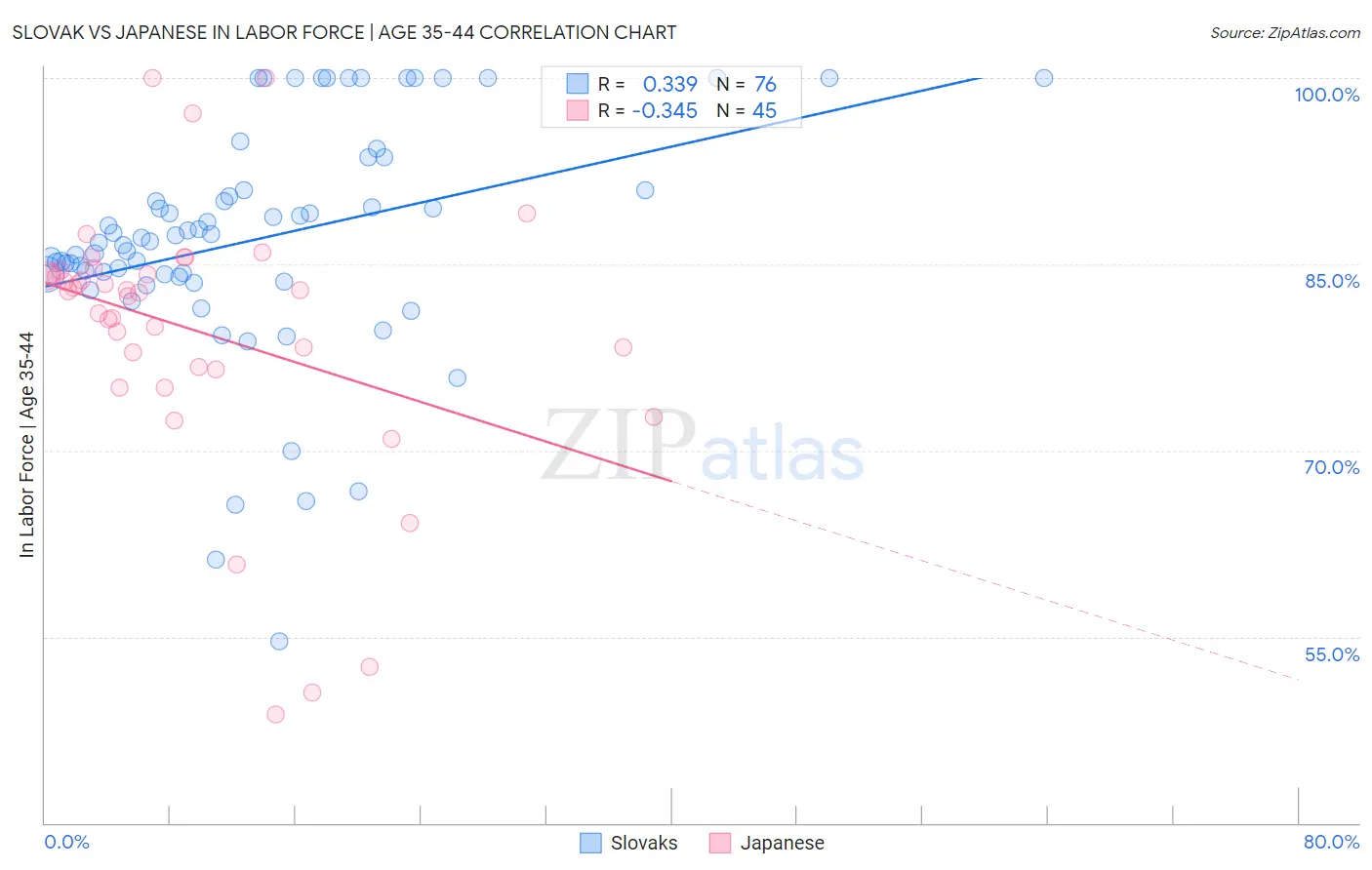Slovak vs Japanese In Labor Force | Age 35-44
COMPARE
Slovak
Japanese
In Labor Force | Age 35-44
In Labor Force | Age 35-44 Comparison
Slovaks
Japanese
85.1%
IN LABOR FORCE | AGE 35-44
99.4/ 100
METRIC RATING
58th/ 347
METRIC RANK
83.6%
IN LABOR FORCE | AGE 35-44
0.3/ 100
METRIC RATING
256th/ 347
METRIC RANK
Slovak vs Japanese In Labor Force | Age 35-44 Correlation Chart
The statistical analysis conducted on geographies consisting of 397,675,153 people shows a mild positive correlation between the proportion of Slovaks and labor force participation rate among population between the ages 35 and 44 in the United States with a correlation coefficient (R) of 0.339 and weighted average of 85.1%. Similarly, the statistical analysis conducted on geographies consisting of 249,106,093 people shows a mild negative correlation between the proportion of Japanese and labor force participation rate among population between the ages 35 and 44 in the United States with a correlation coefficient (R) of -0.345 and weighted average of 83.6%, a difference of 1.8%.

In Labor Force | Age 35-44 Correlation Summary
| Measurement | Slovak | Japanese |
| Minimum | 54.6% | 48.7% |
| Maximum | 100.0% | 100.0% |
| Range | 45.4% | 51.3% |
| Mean | 87.0% | 79.7% |
| Median | 87.0% | 82.9% |
| Interquartile 25% (IQ1) | 84.1% | 76.6% |
| Interquartile 75% (IQ3) | 91.0% | 84.4% |
| Interquartile Range (IQR) | 6.9% | 7.8% |
| Standard Deviation (Sample) | 9.4% | 10.7% |
| Standard Deviation (Population) | 9.3% | 10.6% |
Similar Demographics by In Labor Force | Age 35-44
Demographics Similar to Slovaks by In Labor Force | Age 35-44
In terms of in labor force | age 35-44, the demographic groups most similar to Slovaks are Serbian (85.1%, a difference of 0.0%), Chinese (85.1%, a difference of 0.010%), Albanian (85.1%, a difference of 0.010%), Immigrants from Croatia (85.1%, a difference of 0.020%), and Immigrants from Latvia (85.0%, a difference of 0.020%).
| Demographics | Rating | Rank | In Labor Force | Age 35-44 |
| Immigrants | Albania | 99.7 /100 | #51 | Exceptional 85.1% |
| Immigrants | Kenya | 99.6 /100 | #52 | Exceptional 85.1% |
| Taiwanese | 99.6 /100 | #53 | Exceptional 85.1% |
| Turks | 99.5 /100 | #54 | Exceptional 85.1% |
| Soviet Union | 99.5 /100 | #55 | Exceptional 85.1% |
| Immigrants | Croatia | 99.5 /100 | #56 | Exceptional 85.1% |
| Chinese | 99.4 /100 | #57 | Exceptional 85.1% |
| Slovaks | 99.4 /100 | #58 | Exceptional 85.1% |
| Serbians | 99.4 /100 | #59 | Exceptional 85.1% |
| Albanians | 99.4 /100 | #60 | Exceptional 85.1% |
| Immigrants | Latvia | 99.3 /100 | #61 | Exceptional 85.0% |
| Immigrants | Moldova | 99.3 /100 | #62 | Exceptional 85.0% |
| Immigrants | Uganda | 99.3 /100 | #63 | Exceptional 85.0% |
| Swedes | 99.2 /100 | #64 | Exceptional 85.0% |
| Immigrants | Brazil | 99.2 /100 | #65 | Exceptional 85.0% |
Demographics Similar to Japanese by In Labor Force | Age 35-44
In terms of in labor force | age 35-44, the demographic groups most similar to Japanese are Immigrants from the Azores (83.6%, a difference of 0.020%), Basque (83.6%, a difference of 0.020%), Tongan (83.6%, a difference of 0.040%), Tsimshian (83.5%, a difference of 0.040%), and Salvadoran (83.6%, a difference of 0.060%).
| Demographics | Rating | Rank | In Labor Force | Age 35-44 |
| Immigrants | St. Vincent and the Grenadines | 0.7 /100 | #249 | Tragic 83.7% |
| Whites/Caucasians | 0.5 /100 | #250 | Tragic 83.6% |
| Salvadorans | 0.4 /100 | #251 | Tragic 83.6% |
| Immigrants | Guyana | 0.4 /100 | #252 | Tragic 83.6% |
| Lebanese | 0.4 /100 | #253 | Tragic 83.6% |
| Tongans | 0.4 /100 | #254 | Tragic 83.6% |
| Immigrants | Azores | 0.3 /100 | #255 | Tragic 83.6% |
| Japanese | 0.3 /100 | #256 | Tragic 83.6% |
| Basques | 0.3 /100 | #257 | Tragic 83.6% |
| Tsimshian | 0.2 /100 | #258 | Tragic 83.5% |
| Immigrants | El Salvador | 0.2 /100 | #259 | Tragic 83.5% |
| Vietnamese | 0.2 /100 | #260 | Tragic 83.5% |
| Immigrants | Dominica | 0.2 /100 | #261 | Tragic 83.5% |
| Immigrants | Congo | 0.2 /100 | #262 | Tragic 83.5% |
| Iroquois | 0.2 /100 | #263 | Tragic 83.5% |